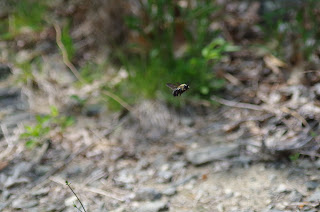It's fun when I read something about a bug and then I see the bug performing the behavior I read about. So when I saw a bee today that was doing something that I read about bees doing, I thought it was really cool.
Case in point - Backyard Bug of the Day:
Carpenter bee. I read somewhere recently (I wish I could remember where) that male carpenter bees will guard the entrances to a number of female carpenter bees' nests at the same time. Now, I have no idea where there might have been female carpenter bees' nests that this carpenter bee could have been guarding, because what is in this area is an outcropping of bedrock, not wood, but he was definitely on patrol. He was hovering, and would move gradually along in front of a particular section of rock about ten feet wide, and would then circle around to start again at the other end. It gave me a few looks, and I guess decided I was not hurting anything - I have also read that male carpenter bees can be very aggressive toward humans, but that they lack a stinger, so they can't hurt you (while females are not aggressive unless you actually attack their nest, and they do sting).
The hovering behavior meant I could get pictures of it in the air, even though I couldn't get close to it, so here are a whole lot of pictures of a carpenter bee on patrol.
I have to begin by saying that before today, I was
confused about the difference between bumblebees and carpenter bees.
Actually, I thought that they were the same thing, that carpenter bees
were a kind of bumblebee, or that both were common names for the same
kinds of bees. But that is not the case - they aren't even in the same
genus. According to The Bees In Your Backyard, by Joseph S. Wilson and Olivia Messinger Carril, carpenter bees are in the genus Xylocopa (Greek for wood-worker)
and Bumblebees are in the genus Bombus, which, by the way, is now my
favorite insect genus name. Bumblebees are fuzzy, and carpenter bees have a shiny, non-fuzzy abdomen. Generally, carpenter bees nest in holes they dig in wood (or plant stems, for some species), and bumblebees nest in the ground (or leaf litter, that ever-popular insect hangout). I have no idea what, exactly, this male carpenter bee was guarding, but it was very interesting to watch, now that I know what his behavior is all about.
Reading! It will teach you interesting things!
Random Bugs:
Much to my dismay, it turns out this is a gypsy moth caterpillar. And that huge egg mass of caterpillars that hatched a couple of weeks ago was full of gypsy moth caterpillars that have now dispersed out into the world. I didn't realize that that's what they were, because they look different in these early instars. Sigh.
Leaf hopper
I don't know what kind of beetle this is, but it would appear that it is one of the leaf beetles.
Ant tending to some aphids, nymphs and imago.
More ants tending to more aphids. The ants eat the honeydew that the aphids secrete, and in turn the ants protect the aphids from predators that want to eat them.
Beetle
Can you see the tiny springtail?
Arachnid Appreciation:
.
.
.
.
.
.
.
.
.
.
.
.
Six-spotted orb weaver. This is the largest one I have ever seen, and coupled with its small pedipalps, I would guess that means this is a female.
This is the point when she got tired of me being in her face and dropped down onto the grass.



























No comments:
Post a Comment